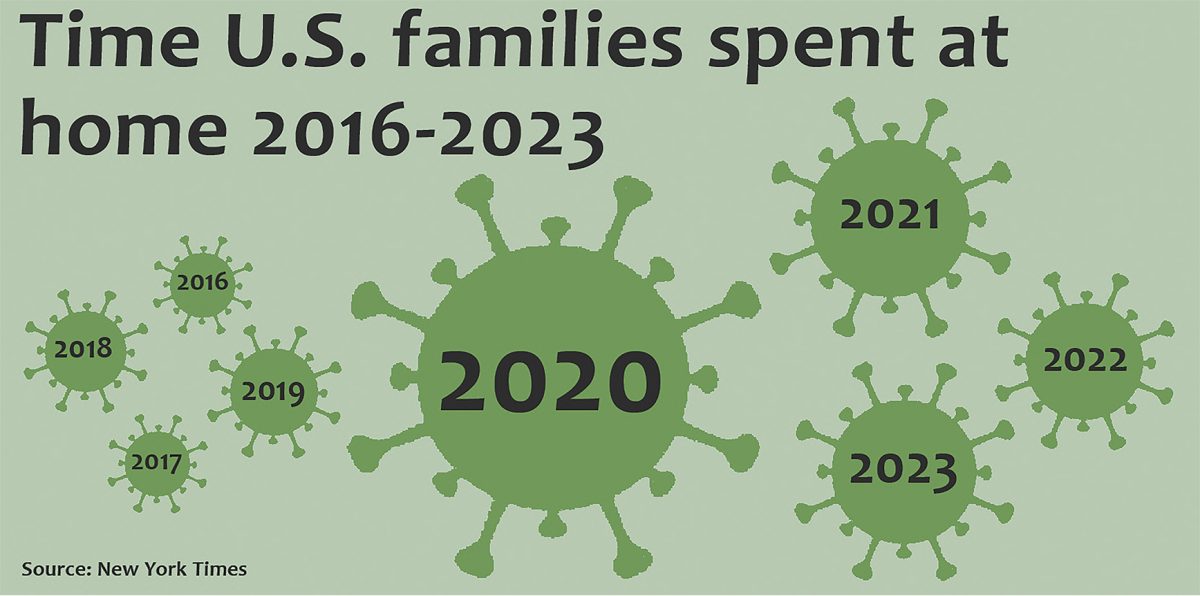
Time U.S. families spent at home 2016-2023 (New York Times).
In March of 2020, COVID-19 put millions of people across the globe into isolation. Ranging from fourth to seventh grade, current high school students were among those whose social lives were put on hold. While the district eventually morphed from completely online to completely in person, the COVID-19 pandemic had an effect on student friendships that is still playing out today.
As students went home for an isolated spring break, junior Emily Wasserstrom explained socializing was not at the top of her priority list.
“I ghosted everybody,” she said. “I never reached out to anybody nor did anybody reach out to me.”
Part of the disconnect was due to Wasserstrom’s long-term fear of germs, she added.
“If I was walking my dog, I would put on gloves, two masks, sweatpants and a sweatshirt, so I had none of my skin exposed,” she said.
Senior Leah Rogers explained when the fourth quarter began, the classroom moved from in person to virtual; to retain relationships, many students took to the Internet to connect and communicate online, which became the standard.
“I could text and call people, but it wasn’t the same as actually meeting up,” she said.
Senior Noah Mack said virtual connection wasn’t a sustainable practice among his pre-pandemic friendships.
“At the very beginning, we stayed in touch almost every day,” he explained. “When it got further out from when it started, we didn’t talk nearly as much; we wouldn’t see each other because you couldn’t.”
Senior Grace Armstrong said although her friends used Skype to connect online, it wasn’t as rewarding as seeing each other in-person.
“It was harder to communicate,” she said. “We would do what we could, masked, but it was very rare.”
By the second quarter of the 2020-21 school year, students began returning to the school building; they were split into two groups based on last name, allowing each group to learn in person for two days each week.
At first, being divided up was difficult for Rogers, she explained, whose last name was in a different group than her pre-pandemic friends.
“I was scared that I wasn’t going to have friends in my classes anymore,” she said.
However, returning to the building allowed Rogers to expand her social circle, she added.
“When it did start, I remember making new friends in my classes,” she explained. “It was good for me, especially going into high school.”
A big shift in reintegrating happened when the mask requirement was lifted, and Rogers said it took time to relearn what the people around her looked like.
“There were so many people that I hadn’t seen in person or hadn’t seen below their eyes,” she explained. “When teachers came in, after we started to stop wearing masks, [I felt like] I’d never seen their faces before.”
Although many students returned to the building as soon as they were allowed to, Armstrong said her family’s reservations about getting the virus encouraged her to stay online for an additional school year.
“There were so many unknowns,” she added. “We were specifically very scared of long term effects, so we wanted to take the least risk that we could.”
Because she continued learning online, Armstrong explained she spent much more time with her family than her pre-pandemic friends.
“I remember going to Havenwood Park and hanging out masked and six feet apart,” she said. “Other than that, I mostly just saw my siblings.”
Mack said being separated from his school friendships allowed him to grow closer to his nuclear family.
“My mom and I were best friends for a little while,” he said.
Spending time outdoors with his family became a normal occurrence, Mack added.
“We would go out with our dog to parks around town,” he said. “We would just walk for three hours.”
Wasserstrom explained family was also central to her pandemic experience; being in isolation allowed her to grow much closer to her dad.
“He and I share a lot of interests,” she said. “We took it upon ourselves to make the best of a horrible situation.”
One of the scariest parts of 2020 was when close relatives tested positive for COVID-19, Mack said; that apprehensiveness severely limited his desire to socialize.
“My family in Michigan got it twice before the vaccine, and I was so worried they were going to die,” he explained. “It was horrible; you can’t go and take care of them because then you’ll get it.”
Wasserstrom said having a strict barrier between herself and her peers had consequences that took a long time to undo.
“If the same thing were to happen over again today, I would not handle it the same,” she said. “I would be more proactive about reaching out to people. COVID led me into a very dark place mentally because I was so isolated from everybody.”
Rogers explained she still feels like the COVID-19 pandemic and quarantine happened recently.
“It’s crazy that it’s been five years,” she said. “I feel like I’m still 12.”
Armstrong said being separated for so long had a lasting effect on the senior class.
“We’re a lot quieter than we were before COVID,” she said. “As a group, we’re less likely to participate, and I think it’s because of having online classes.”
Published April 2025. Digitized 2025.